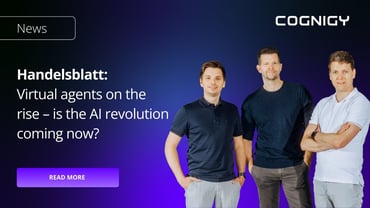There are two complementary trends in conversational interaction that are taking hold in Marketing and Customer Service organizations. First, consumers expect to be able to interact with brands in their channel and modality of choice. Historically, this has been through web, mobile, and email, but new forms of interaction are becoming increasingly standard. We now expect conversational experiences – either by voice or chat – to be an avenue of engagement between consumers and brands. As consumers move to interactions over voice (i.e. Alexa, Google Home or Siri) and chat (i.e. Facebook Messenger, WeChat, and text), brands need to implement solutions that meet consumers in these modalities.

Second, organizations need to provide personalized conversations at scale. We need to interact with consumers in a way that feels relevant and efficient while also managing cost. While using technology to drive efficiency isn’t a new requirement, we now need to provide experiences that are personalized to a consumer’s profile and needs.
All of this makes sense, but it doesn’t tell you how to get started. What is your first conversational project? How long will it take and how much will it cost?
Recently, I met with a progressive CMO, at the early stage of understanding how conversational AI could apply to his organization. Our discussion centered around an important foundational concept: “Think about inflection points where you are spending piles of money on conversations, and look for opportunities to optimize.” In his scenario, the inflection point was lead generation powered by advertising, and the cost was human to human chat with online service reps. He faced four issues: 1. to scale with projected advertising, he would need to ramp his team by 1400%; 2. he wanted brand consistency across all interactions; 3. he struggled with training his sales reps in the best practices of engagement; and 4. he wanted to provide 24/7 availability.
His immediate thought was “OMG, how do I replicate this interaction with a chatbot?” Conversational design can be overwhelming. Someone could type anything, and you need to figure out how to gracefully respond to it. The mental model is infinitely complex, and volume of content required to support it is basically… everything.
For this CMO, we wanted to start with a baby step, and introduce the concept of a conversational Micro-Moment. To identify a Micro-Moment, let’s ask ourselves two things:
- Where can a conversational UI enhance the visitor experience?
- How can a conversational UI help give a brand just a little additional context to engage?
In the above scenario, let’s not try to boil the ocean and replicate a human with a bot. Let’s do two simple things. The first is to allow the bot handle the initial engagement. Beyond capturing simple contact data, let’s uncover the visitor’s motivation, potentially solve the visitor’s inquiry, and try to gain enough insights to route the request to a human specialist. Here, we are providing triage and a level one response. This is a simple place to efficiency while still keeping a human agent as part of the solution.
The second is to think about redundant human tasks which could be passed back to a bot, such as capturing form data to complete a transaction or other time-consuming rote activities.
We explore in other articles the emerging trends of conversational micro-moments in search, navigation, forms, and even within a hero image call to action.
Micro-moments give brands an opportunity to dip their toe in the conversational water, test, refine, and ultimately expand the functionality. You can accomplish this without having to boil the chatbot ocean.
In our paper on Building a Conversational Practice, we explore the natural progression to extend conversational UI to additional channels and devices, marry functional departments (sales, support, marketing, HR), and gracefully move a visitor from conversation to conversation without losing context.
COGNIGY.AI is an enterprise software product that enables the creation, deployment and maintenance of natural language conversational AIs, either in spoken or written form. The framework includes all components necessary to run across channels (such as Facebook, Alexa, Web, VR/AR, embedded), including NLP (Natural Language Processing), NLU (Natural Language Understanding), answer generation (Cognigy Flow Engine), conversation analytics, and interfaces for marketing/communication teams.





.png?width=60&height=60&name=AI%20Copilot%20logo%20(mega%20menu).png)


